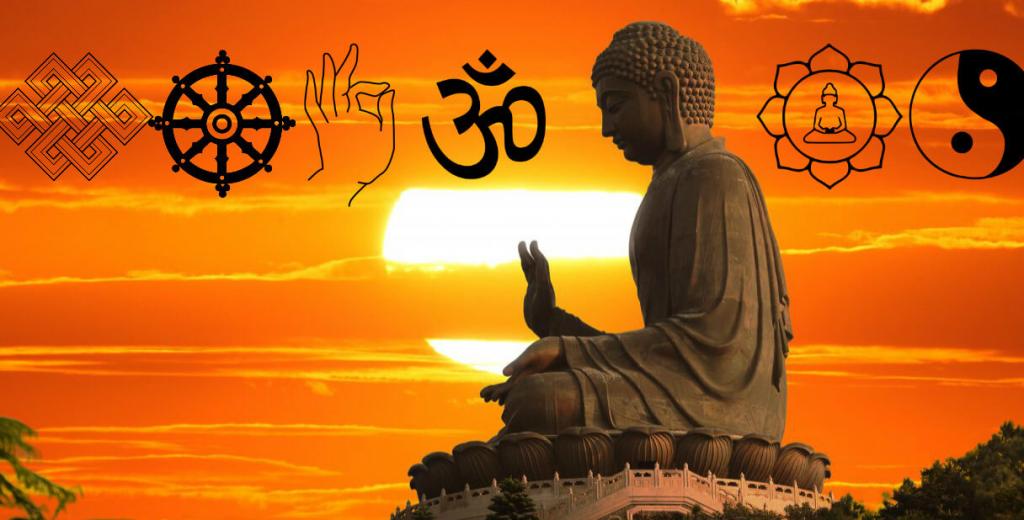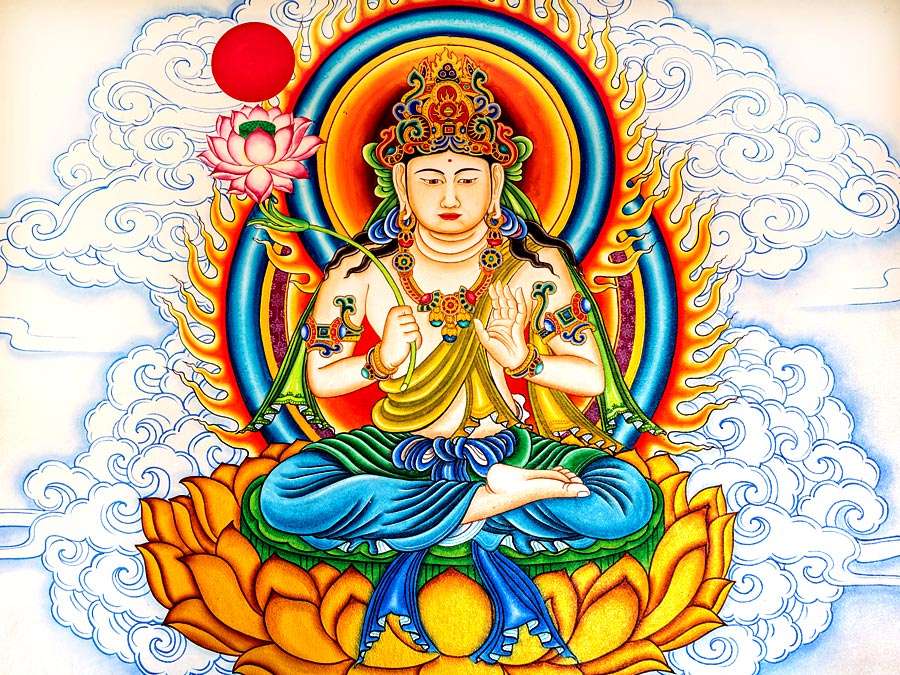The definition of tantric Buddhism is a pyramid, it is based on the monastic life common to all forms of Buddhism. The summit is a meditation on emptiness, on the unity of all things and the impermanence of every element of the universe, where only the absolute is eternal.
Religion of tibet
The fundamental difference between Buddhism and other religions is that it is a doctrine of the inner world of man, of the mind. Consciousness and mind in eastern languages are synonyms. A state of dissatisfaction, suffering, or joyful bliss is, first of all, a state of mind. All external attributes are important if you understand their meaning. Otherwise, they are simply useless, that is, they are things of the second order. When practicing tantric Buddhism in the soul, such states as love, compassion and patience arise. Thirst is the cause of all negative emotions, such as envy, anger, pride, fear and so on. The fundamental reason for all this is ignorance, a misunderstanding of who you are and what this world is. Buddhism is not an ordinary religion. There is no God in understanding the separate entity that created this world. Buddha is neither God nor Savior. He did not invent the truth, but discovered it. Buddha compared himself to a doctor, he said that all people are sick, and this disease has a reason and prognosis - it is treatable. A. G. Fesyun "Tantric Buddhism" is a collection of various esoteric translations. And now a little about the story.
History of Tantric Buddhism
The original religion in Tibet was Bon. People worshiped two Gods, who were Heaven and Earth. A great role was played by shamanistic ceremonies and communication with spirits. Then Buddhism began to spread in Tibet, and the two religions merged together. So Tibetan Buddhism appeared.
Tantrism and sensuality
Tantric Buddhism is a later continuation, the evolution of Buddhism. Instead of a monastic departure from the world, instead of giving up feelings, sensuality and desire, he embarked on the path of desire and the transformation of our everyday passions into enlightened knowledge. The idea of the unity of wisdom and passion, the ways that lead us to enlightenment. The woman here is the embodiment of primordial wisdom. The reality of the sexual practices of tantric Buddhism is very different from the widespread perception of them in the West, which became fashionable thanks to the followers of tantric sex. They have nothing to do with prolonging pleasure. Their main meaning is to achieve a state that goes beyond desire and beyond pain. That is, with the help of the body to go into those sensual spheres that are usually inaccessible to us, and sexuality, since it releases a huge amount of energy - the main means of achieving this state.
Characteristics of Tantric Buddhism
Consider the main features. Sexual symbolism, yogic practices, the pantheon of gods, the sensual realm and tantric vows in Buddhism are the main characteristics of the religion of Tibet. Performing Tibetan rituals often takes several days and involves many hours of presence in the temple. Food and tea are distributed among the monks during the ceremony. Tibetan tea is brewed with oil and salt, and one such cup gives as much energy as a full meal. As one progresses in meditation, the consciousness becomes thinner and cleansed. The ancient science of visualization and tantric deity with its symbolic attributes does not correlate well with our ideas about the structure of consciousness. However, its theoretical and practical aspects are confirmed in modern scientific research in the field of depth psychology. This is a technique of self-knowledge and appeal to the forces that are actively present in our subconscious. And, most importantly, it provides direct assistance in the search for liberation - nirvana.

Meditative practices
Tibetans do not meditate with their eyes closed, but with their eyes open. They focus their eyes on the tip of their nose. The body should be completely relaxed, it takes a position that can be maintained for several hours without experiencing stress. Some tantric meditations are based on visualization, visions that require neither drugs nor hallucinogenic mushrooms. These meditations last for several hours, and sometimes for several days. Buddhists use a belt to support the body in a fairly comfortable position.
Chakra centers
Yogins distinguish five chakras or centers within the body: the root, umbilical, cardiac and throat, and the center in the head, called the thousand-petalled lotus. The flow of energy circulating in the body is also described. The two main streams run along the spine. The first ends in the left nostril, the second in the right. The energy, or prana, which fills the whole universe with life, enters the body with the air that we breathe, and circulates in these subtle energy channels. That is why certain breathing exercises are so important, as well as careful conscious participation in the respiratory process, which begins with the child’s first breath and ends with the last breath of a dying person.
The prevailing school of tantric Buddhism. Rituals
Red Riding Hoods is a school of Tibetan Buddhism, Tantric Buddhism and Lamaism. Among her followers are both hermits and lay practitioners. These monks devote themselves fully to the study of metaphysics for many years.
Tantric rituals are like a dramatic performance, to which all its participants take very seriously. But all these rituals, sometimes confusing with a superficial gaze, are intended to achieve liberation from attachment - the main goal of Buddhism. Rituals can be held for their immediate participants. And also in order to rescue the unfortunate evil spirit and soul from purgatory. If the ritual is designed to ruthlessly separate the forces of death from the forces of life, then they should inspire horror and scenery, against the background of which this surgical operation in the field of spirituality is carried out. There are three characters involved in this drama. First, the sacrifice is a symbol of attachment to the ego, which blinds us, not allowing us to see the eternal reality inherent in us. Secondly, the Great destroyer of Mahakal, who rises above the remains in us of a demonic beginning. It destroys what must in any case be destroyed. Mahakala is terrifying, beloved, and it is he who calls us to awareness. He devours and swallows, kills to give life beyond birth and death. And finally, the third character - a ritual master - the tantric Lama Kjensarin Pache, who today is considered in India one of the greatest sages of the school of red-caps.

Yoga practice
Tibetan yoga in its content is significantly different from Hindu yoga, whose poses and elementary breathing exercises are described in popular books that can be found today in the window of any bookstore. However, lovers should be warned that Tibetan yoga is not a product that can be put up for sale on the world market of spiritual industry novelties. You can see only a few exercises that the monks attribute to the simplest, and teach at the initial stages of training. Until recently, these poses were kept in the strictest confidence. Anyone who tried to secretly see them would be severely punished. All bodily yoga is based on a paradox. In an attempt to overcome the limitations of the physical body and go beyond it, the yogi devotes all his attention and effort to the body, because yoga is one of the aspects of tantrism. According to tantrism, nothing should be absolutely rejected, rejected or suppressed. Everything needs to be accepted, integrated and transformed, just as nature turns coal into diamonds, and alchemists talk about converting lead into gold.
No matter what the strictest secrecy of yoga science may be, no matter how heroic the ascetic life of a yogi, and no matter how supernatural and miraculous the results are, these yogis are sages who are in perfect harmony with what everyday life entails. modern man. They are free and pious, fully aware of the present moment, full of calm, joy, kindness and compassion. They are free even from small echoes of the past, both at the level of conscious and unconscious. They are free from the slightest worries about the future. Strength for Tibetan sages is always fraught with compassion. This is not love that is based on an emotional impulse and can turn into its opposite, giving rise to selfishness, envy, hatred and despair. This is another love, its roots lie in comprehending the unity of all beings.